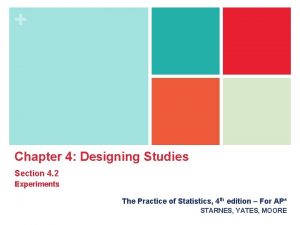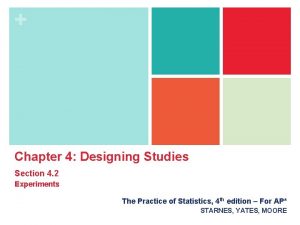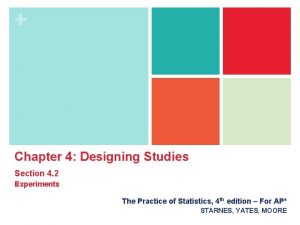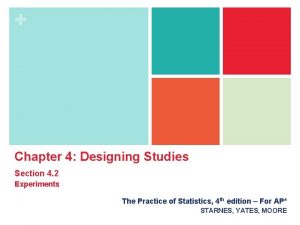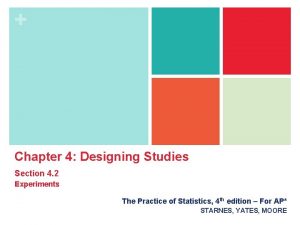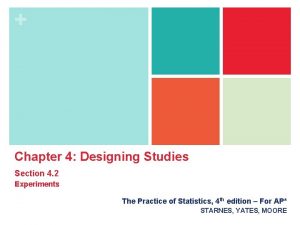Chapter 6 Designing Experiments Section 6 1 Experiments

















- Slides: 17

Chapter 6 Designing Experiments

Section 6. 1 Experiments, Good and Bad

Experiment Deliberately imposes some treatment on individuals in order to observe their responses. The purpose is to study whether the treatment causes a change in the response.

Talking about experiments Subjects Treatment Clinical Trial Individuals studied in an experiment Any specific experimental condition applied to the subjects Experiments that study the effectiveness of medical treatments on actual patients

Placebo effect Placebo A dummy treatment with no active ingredients Many patients respond favorably to any treatment, even a placebo. This response to a dummy treatment is the placebo effect

"One-track" design Impose treatment ⇒ Measure response "Two group" experiment One group given treatment to be tested Second group gets placebos Allows us to see whether the treatment being tested does better than the placebo


Randomized comparative experiments Goal is to ensure that the experiment will show the effect of the explanatory variables on the response variables Random assignment of subjects to groups One group for each treatment (one may be a placebo group) Number of subjects in each group similar Know which treatment each group gets Know which response variable to compare

Figure 6. 2 The design of a randomized comparative experiment to compare hydroxyurea with a placebo for treating sickle-cell anemia.

Logic of experimental design Random assignment produces groups of subjects similar in all respects before treatment Proper comparative design ensures that influences other than experimental treatments operate equally on all groups (eliminates confounding and lurking variables) Therefore, differences in the response variable must be due to the effects of the treatments

Principles of experimental design Control the effects of lurking variables on the response Randomize - use impersonal chance to assign subjects to treatments Use enough subjects in each group to reduce chance variation in the results

Statistical significance An observed effect so large that it would rarely occur by chance is statistically significant Means there is good evidence for the effect being sought

How to live with observational studies Good studies are comparative even when they are not experiments Combine comparison with matching in creating a control group Measures and adjusts for confounding variables

1. Suppose that you want to study whether an SAT prep program actually helps students to score higher on the SAT's. You gather data on a random sample of students who attended the program and you find that 86% of the sample scored higher on the SAT's after attending the program than before attending the program. a) Explain why you cannot legitimately conclude that the SAT coaching program caused these students to improve their scores on the SAT. b) Suggest some other explanations for their improvement. Explain in the context of this problem why one of these might confound the results of this study.

Suppose you wanted to conduct an experiment to investigate whether an SAT prep program would improve students’ scores on the SAT. Assume you have 120 students available for the study. (a) Identify the explanatory variable and the response variables in your experiment. (b) Explain carefully how you would randomize the 120 students to the treatment groups.

A health worker is interested in determining if Omega-3 fish oil can help reduce cholesterol in adults. She obtains permission to examine the health records of 200 people in a large medical clinic and classifies them as to whether or not they take omega-3 fish oil. She also obtains their latest cholesterol readings and finds that the mean cholesterol reading for those who are taking omega-3 fish oil is 18 points lower than for the mean for the group not taking omega-3 fish oil. (a) Is this an observational study or an experiment? Explain. (b) Do these results provide convincing evidence that taking omega-3 fish oil lowers cholesterol? (c) Explain the concept of confounding in the context of this study and give one example of a possible confounding variable.

 Chapter 13 experiments and observational studies
Chapter 13 experiments and observational studies Apush chapter 2 american experiments
Apush chapter 2 american experiments Study guide chapter 10 section 1 meiosis
Study guide chapter 10 section 1 meiosis Product planning and development process
Product planning and development process 7 types of jaycustomers
7 types of jaycustomers Chapter 7 designing organizational structure
Chapter 7 designing organizational structure Chapter 7 designing organizational structure
Chapter 7 designing organizational structure What is matched pairs
What is matched pairs Chapter 14 designing and managing services ppt
Chapter 14 designing and managing services ppt Channel design process
Channel design process Chapter 4 designing studies
Chapter 4 designing studies![[http://earthobservatory.nasa.gov/experiments/biome/] [http://earthobservatory.nasa.gov/experiments/biome/]](data:image/svg+xml,%3Csvg%20xmlns=%22http://www.w3.org/2000/svg%22%20viewBox=%220%200%20200%20200%22%3E%3C/svg%3E) [http://earthobservatory.nasa.gov/experiments/biome/]
[http://earthobservatory.nasa.gov/experiments/biome/] M&m experiments with scientific method
M&m experiments with scientific method Surveys, experiments, and observational studies worksheet
Surveys, experiments, and observational studies worksheet 1980-1896
1980-1896 Counting rule probability
Counting rule probability Engineering projects vs standard experiments
Engineering projects vs standard experiments Science experiments for highschool
Science experiments for highschool







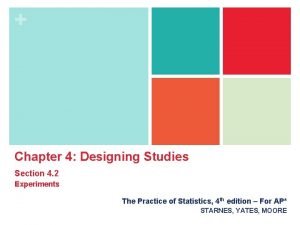


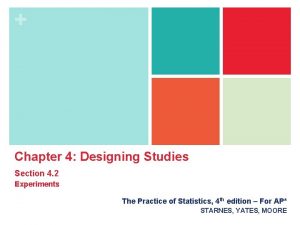
![[http://earthobservatory.nasa.gov/experiments/biome/] [http://earthobservatory.nasa.gov/experiments/biome/]](https://slidetodoc.com/wp-content/uploads/2020/11/1537165_35fb5ecc588217ed14768e866616d64b-300x169.jpg)











